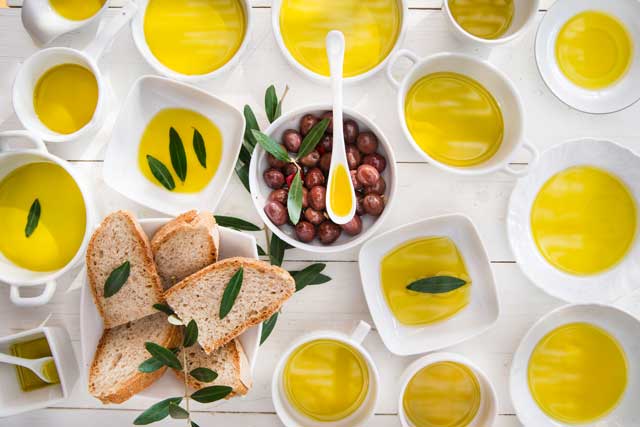In this world of fancy foods, everyone is looking for something extra special. Today, food is something more than filling tummies. People search for better taste, greater hygiene and healthier food. If you get taste, its good, but finding a healthier food is a plus. The struggle does not end here. Many other factors involve when searching for a good meal. However, to your surprise, you can achieve this goal with a special ingredient and that is ‘olive oil’. Cooking with olive oil not only makes the food tastier but also healthier.
Are you conscious of your diet? It is the best advised oil for making the popcorns at home. It contains anti-oxidants and multivitamins, which helps with strong immunity and boosting power. The anti-oxidants help in the coping with oxidative stress in the body. Cooking with olive oil is popular but there still exist some doubts that need attention. Some people are hesitant using olive oil in their cooking because the myth ingrains their mind. They think olive oil should not be used cold and never be cooked. Knocking this out of their head, cooking with olive oil or extra virgin olive oil is fine. Here is the reason you should go with it
A Quick Chemistry
To burst the myth I need to go a bit more in depth. Therefore, I am using some chemistry to convince you fully. It is a little different from the casual school chemistry, but if you still do not feel like it, you can just skip to the conclusion.
Sites of Attack
Starting from the structure, there are two kinds of fatty acids (the building block of oils), saturated and unsaturated. Majorly, three of them make oils, saturated fatty acids, monounsaturated and polyunsaturated fatty acids. They differ in the structure with the number of double bonds. Double bonds are the sites of oxidation. That means where many environmental conditions can interact with the oil and make it impure. The number of double bonds increases in the given manner. The unsaturated fatty acids have no double bond. The monounsaturated has one double bond and the polyunsaturated has many double bonds. The more the unsaturated the more they are prone to oxidative damage. The kinks in the chain are the sites of these double bonds.

This damage called oxidative damage produces trans-fats. These are the most harmful and damaging to our body. This oxidation turns a fat rancid, and a rancid fat is not only potentially harmful, but also tastes bad. How the structure of olive oil does relate to this chemistry? We will discover soon.
Free Sites of Damage
There are some free fatty acids (those which are not attached to glycerol) present in oils. These are free to interact to the impurities and the environment consequently become dangerous to serious levels. Such free sites are definitely attacked by different materials which can make the oil unhealthy for utilization in the kitchen. The amount of this floating fatty acid varies from oil to oil. Therefore, I considered it an important part of my discussion. You will see how it relates to cooking with olive oil.
Smoke Point of Olive Oil
Smoke point is a point of temperature where the oil starts degeneration or gives rise to greenish smoke. That is the point when the oil may set to more oxidation and becomes harmful. So the more the unsaturated the oil is, the more is the damage at smoke point. Sometimes when butter is heated and cooked, smoke rises. Not to be confused with the smoke point, the water in it evaporates. Same is the case with canola oil sometimes. People confuse it with the damage. Olive oil also comes with different smoke levels depending upon the freshness, quality and care. For olive oil the smoking point is 200-249 degree Celsius.
What Comes with the Olive Oil?
The crux of using Olive oil in cooking comes here. Starting with the very first point, I will discuss the structural composition of olive oil. It has 13% of purely saturated fatty acid, 73% of monounsaturated fatty acids and only 15% of polyunsaturated fatty acid. This shows that olive oil is redundant to oxidative damage. Clearly, we can trust in the quality of olive oil.
Use of Olive Oil for Cooking

Getting a better knowhow of this chemistry, one can ask, how does this composition make it a best fit for cooking? Here is the answer. Olive oil has a very few number of free fatty acids and it has a higher smoke point than any vegetable oil. Usually it ranges to 210 degree Celsius. Usually while cooking food, the temperature rises to 120 degree Celsius. Moreover, the deep-frying reaches to 180. Thus, deep-frying or cooking meal with olive oil is completely safe and healthy.
Moreover, to your knowledge, searching of some oil with even higher smoke point is not an efficient move, as it will not provide you with anything further. Sometimes, selecting oil with smoke point more than 220 degree Celsius can be dangerous.
Summary
So the key points why extra virgin olive oil can be used for cooking is the following
- It comes with the most stable monounsaturated fatty acids
- It has least free fatty acids
- It is most redundant to oxidative damage
- It has a safe level of smoke point that is 220 degree Celsius, below which you can cook food out of harm’s way
Since olive oil has, so many well-researched supporting documents that provide with its advantages. You can use it, cook with it, dress the food with it, and deep-fry in it. Giving a marvelous taste to your meal, olive oil can be a best option you can opt for your family as a healthy diet. As a plus point, cooking with olive oil increases the antioxidant qualities of your food to a significant level. Therefore, you can enjoy all the traditional and present styles of cooking with extra virgin olive oil.

Buy the best spanish extra virgin olive oils in our online store.

